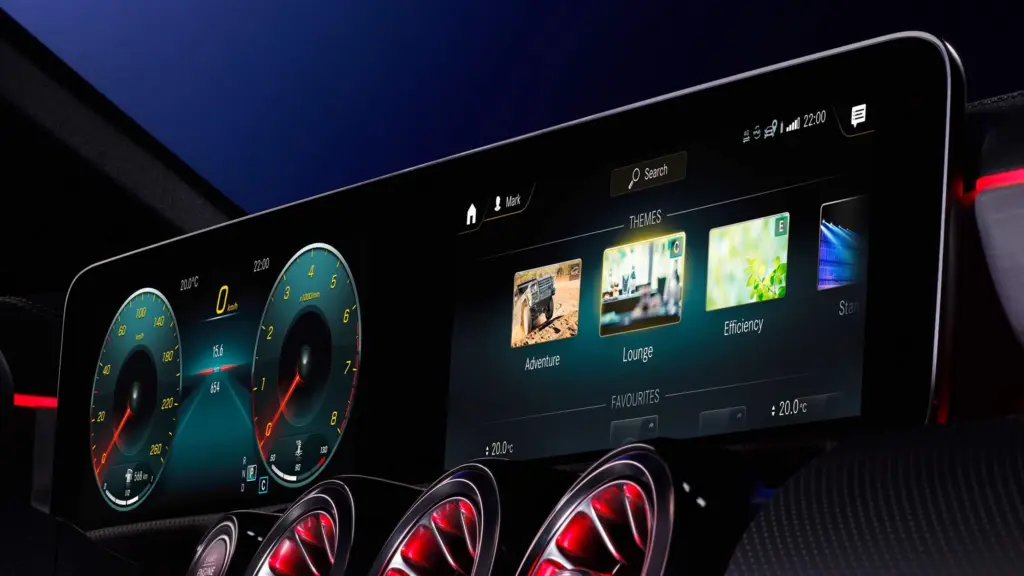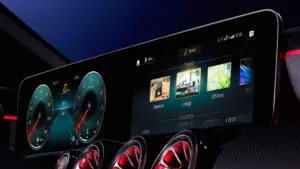Writing doesn’t pay much but if it did, it would pay for my 2024 Mercedes-Benz E-class sedan a return to the traditional three-box sedan proportions of the classic Mercedes. I do not know much else about the car’s engine, its road handling, or any of the basic engineering that a car enthusiast would care about. It looks right and it is a Mercedes. Also, the car is designed to appeal to someone who is on their smartphone the whole time which is my demographic. Therefore, it boasts an impressive list of features for the interior of the car that recreate the user experience of a phone. I tried to list them out in no particular order.

- Superscreen: A dashboard-sized glass panel with three screens, offering two display styles (Classic and Sporty) and three modes (Navigation, Assistance, Service) for individualized graphics.
- a. Driver’s screen: 12.3 inches, customizable settings and digital driving information, with an optional 3D driver display using autostereoscopy for a real depth effect. The optional 3D driver display allows spatial scene perception with a real depth effect. The system uses autostereoscopy for the 3D effect: here, the LCD display combines a special pixel structure with a controllable LCD aperture grill. The result is that the left and right eye see different pixels of the LCD, creating the illusion of depth.
- b. Center stack screen: 14.4 inches, manages climate and entertainment functions.
- c. Passenger’s screen: 12.3 inches, for streaming entertainment and playing touchscreen-based games, with seat occupancy recognition and digital decorative feature when unoccupied.
- MBUX multimedia system options: Premium and Premium Plus (including passenger display with extended Superscreen glass surface from A-pillar to central display).
- Up to five cameras observing the driver and passengers, enabling AI features and allowing Zoom meetings from the car (while parked).
- In-car apps, including Zoom, Vivaldi web browser, TikTok, and Angry Birds.
- “Zero layer” user experience, providing personalized suggestions for infotainment, comfort, and vehicle functions without navigating submenus or using voice commands.
- MBUX Augmented Reality for navigation, superimposing graphic navigation and traffic information on live images.
- “Hey, Mercedes” voice recognition system for handling more natural language commands.
- Models without Superscreen have a large trim element with a visually detached central display.
- Artificial intelligence learns routines and adapts to them, with customers able to create their own routines in MBUX, linking conditions and functions.
- Traditional luxury options: Nappa leather and various color options, including beige, gray, and cinnamon-colored Tonka Brown.
- Energizing comfort: Syncs music, light, and available massaging seats to maintain driver fitness and enhance road safety. Programs can energize a tired driver or calm a stressed one.
- Optional Burmester 4D surround sound system with 21 speakers and sound transducers in seat backrests, translating sounds into vibrations.
- New MBUX presentation with simplified main icons, based on smartphone tile colors.
- 5G communication module for faster data rates than LTE/UMTS.
- Active light strip in the instrument panel and front door panels for a visual interpretation of entertainment sound content.

The E-class sedan may be considered to be a premium or luxury car, but the features are very likely to trickle down to more affordable cars in the very near future. Other cars may not have the same quality setup and all of the trimmings of the E-class cockpit (the MBUX or Mercedes-Benz user experience) but the functionality is replicable in software. That is what makes automotive displays so interesting, it is the possibilities that are opened up by using a lot of the free surfaces inside the car for displays.

